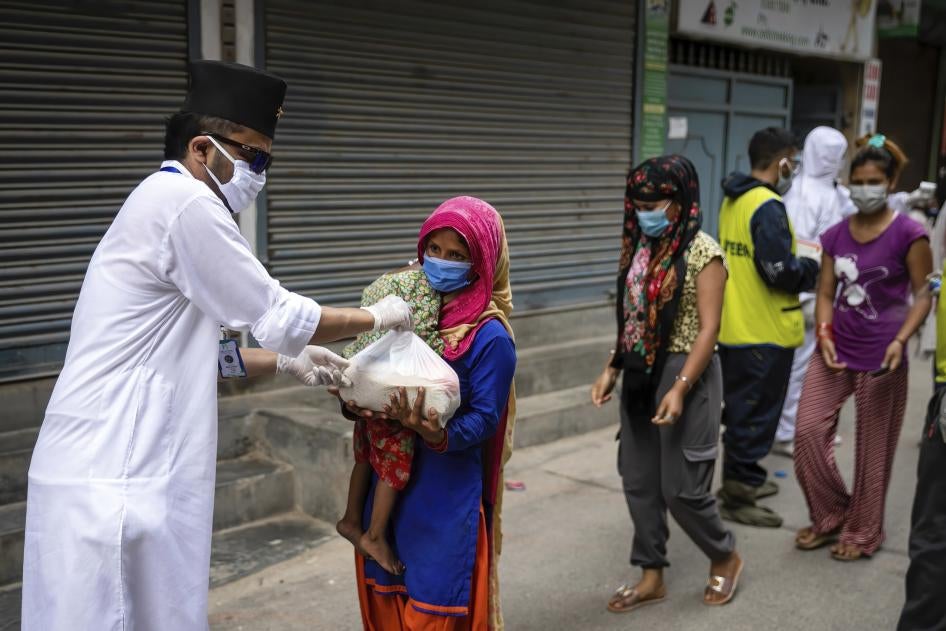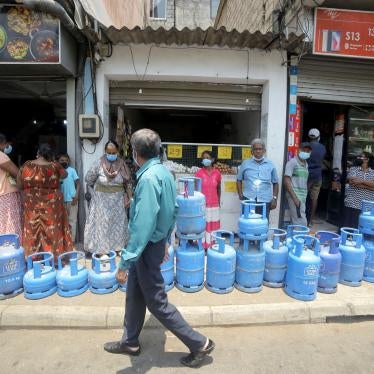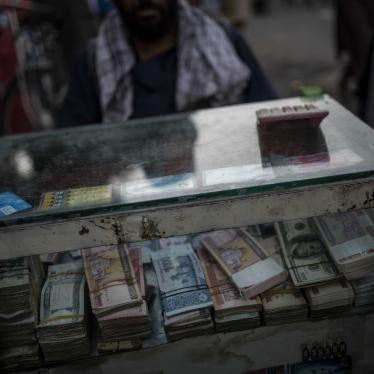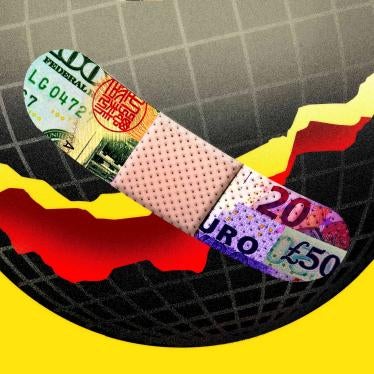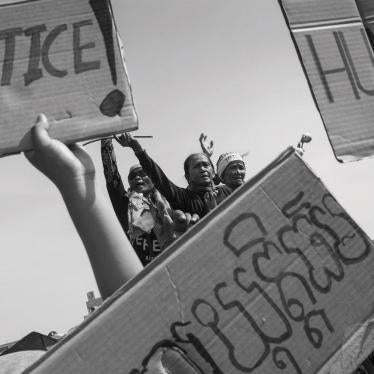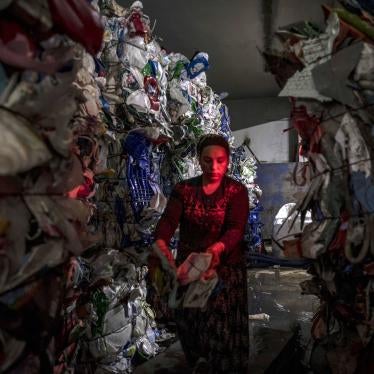(Washington, DC) – Targeted social protection programs intended to cushion people from the economic impacts of the Covid-19 pandemic have only had limited success in protecting human rights, Human Rights Watch said today. The World Bank and International Monetary Fund (IMF) should adopt a different approach that facilitates universal social protection during their Spring Meetings that begin the week of April 17, 2022.
Social protection programs seek to reduce or cushion people from poverty, particularly in situations that affect their ability to earn an adequate income such as sickness, disability, old age, unemployment, and childrearing. Programs can include cash and in-kind transfers, pensions, public works, and school feeding programs. Social protection programs can be universal, designed to benefit everyone in a certain group. Or they can be means-tested, targeted to those who meet certain criteria, often based on income. IMF loans and World Bank projects have largely promoted targeted programs, though the Bank acknowledged universal social protection to be key to combat poverty and inequality.
“One of Covid-19’s many painful lessons is that targeted social safety nets leave large segments of the population vulnerable to hunger, homelessness, and other problems,” said Lena Simet, senior researcher and advocate on poverty and inequality at Human Rights Watch. “Yet the IMF and World Bank appear to be doubling down on this second-rate approach to social protection.”
Well-designed social protection measures are powerful tools for governments to reduce poverty and economic inequality and to meet their human rights obligations. Social protection is enshrined as the right to social security in the Universal Declaration of Human Rights and in the International Covenant on Economic, Social, and Cultural Rights. It is key to securing other economic and social rights, in particular the right to an adequate standard of living, which includes the rights to food and to adequate housing.
The Covid-19 pandemic underscores the importance of social protection and has led to unprecedented government action. Between February and May 2020, 168 countries and territories announced at least 915 social protection measures in response to the pandemic. Yet, more than four billion people are not covered at all, based on International Labour Organization (ILO) estimates. Only one in four of the world’s children had social protection coverage, and just 18.6 percent of unemployed people received unemployment benefits.
A Human Rights Watch analysis of 16 countries, including of relief specific to the pandemic, found that targeted programs excluded millions of people who were in need of social security to protect their rights, leaving them without adequate food and with other problems. Human Rights Watch analyzed measures in Austria, Cambodia, Cameroon, Ghana, Jordan, Kazakhstan, Kenya, Lebanon, Nepal, Nigeria, Spain, Turkmenistan, Uganda, Ukraine, the United Kingdom, and the United States. Human Rights Watch also reviewed the 19 IMF loan programs approved between March 2020 and December 2021 and analyzed numerous World Bank social protection projects approved during the pandemic.
Governments and international financial institutions expanded existing social protection programs and introduced new ones in the countries where Human Rights Watch conducted research. But almost all were targeted and were insufficient or not meaningfully responsive to the economic realities of people living in poverty and those in precarious employment or excluded parts of the population, Human Rights Watch found. As social protection responses have largely piggy-backed on existing systems, they have exposed – and in some cases worsened – deep-seated inequalities in access to social protection.
For example, Jordan expanded its cash transfer program to reach 240,000 households in 2021, but that left millions of people without support when poverty is estimated to have spiked from 15 percent to as much as 24 percent of the population of roughly 10 million in a matter of months. The country’s large refugee population, most of whom live in poverty, is not covered, but has to rely on aid agencies. Kenya implemented a Covid-19 cash transfer program that targeted just 21 of Kenya’s 47 counties. Human Rights Watch research found it reached only a tiny fraction of the targeted populations and left millions of people in Nairobi county’s informal settlements with no support despite dire need.
These findings are consistent with a growing body of research that has shown that universal social protection programs are more effective at reducing poverty and inequality. By extension, they offer a better opportunity for more people to realize their rights, including to an adequate standard of living. Targeted programs are often designed too narrowly and exclude many people in need; selection processes are frequently costly, inaccurate, and prone to mismanagement or corruption; and many eligible people find it hard to apply or don’t apply due to the stigma associated with poverty. Targeted programs have also been found to breed resentment by leaving people out, eroding public support for maintaining them.
In recent years, some leading institutions, including the World Bank, have embraced universal social protection. In 2012, the ILO adopted Recommendation No. 202 on social protection floors calling on members to ensure “the universality of protection, based on social solidarity.” Four years later, the World Bank announced it would partner with the ILO to advance universal social protection, which it calls “central to its goals of ending poverty and boosting shared prosperity.”
Any change by the World Bank would be enormously influential as it provides two-thirds of global aid to low-income countries for social protection. According to the World Bank, by April 2022, its safety net portfolio has reached US$26.55 billion in 71 countries. In a 2019 white paper, Protecting All, the World Bank said it “wholly endorses the objective of universal social protection espoused by the international development community.” The World Bank, along with the ILO, co-chairs the USP2030, a multistakeholder initiative to achieve universal social protection by 2030.
But the World Bank appears to be continuing to invest primarily in means-tested targeted programs, according to research published by several organizations, as well as the Human Rights Watch review of numerous Bank-funded projects. In a statement to Human Rights Watch, the World Bank said the Covid-19 pandemic and other recent crises “remind us for the need of universal social protection,” and that it is investing in “building and strengthening adaptive and sustainable social protection systems, which are crucial to safeguarding the poor and vulnerable to shocks.”
The IMF has not embraced universal social protection even in principle and continues to favor targeted social protection programs including those approved since the pandemic began. A Human Rights Watch review of all 19 IMF loan programs approved between March 2020 and December 2021 found that all social protection measures and policy advice were for targeted programs.
“The IMF and World Bank have made building inclusive economies central to their support for economic recovery,” said Simet. “Promoting universal social protection is key to succeeding at that goal.”
World Bank and IMF Approach to Social Protection
Despite the World Bank’s announcement in 2016 that it would partner with the ILO to advance universal social protection, analyses by other nongovernmental organizations of pre-pandemic programs found that the Bank has remained committed to targeted programs. The European Network on Debt and Development (Eurodad), a civil society network advocating human rights-based financial and economic systems, published a report in 2019 analyzing loan conditions in development policy operations in 46 countries in 2017, the year after the Bank announced its universal social protection partnership.
These operations provide general development financing, rather than funding for specific projects, conditional on certain policy reforms. The analysis found that just 18 of 434 total lending conditions related to social protection, and 12 of those focused on enhancing targeting rather than expanding coverage.
A 2018 analysis by Stephen Kidd, a social protection specialist at Development Pathways, a consultancy group that supports developing countries in creating social protection programs, found several instances in which the World Bank, working with the IMF, actively opposed existing or proposed universal programs, including for child benefits, in favor of targeted ones.
A Human Rights Watch review of about 20 World Bank-funded projects accessed in August 2021 by searching under the theme “social protection” on the World Bank’s website, also suggests that it continues to fund targeted programs despite the exigencies of the crisis.
The projects are different in many respects and vary widely in the amount of lending, but all are targeted. Typically, they expand the number of beneficiaries covered, and create systems to identify and select beneficiaries. Some also introduce “adaptive” social protection systems that can be scaled up in emergencies. For example, in Seychelles, a World Bank project is working in tandem with an IMF loan program to revise a universal program for older people and people with disabilities to make it targeted. There is also a growing push to automate and digitize social protection programs, such as by delegating the means-testing process to algorithms and moving the application for benefits and their delivery to online systems.
The World Bank told Human Rights Watch that its “financing for safety nets projects alone has reached US$26.55 billion (including $15.64 billion in IDA) in 71 countries,” and that it is investing in developing “adaptive social protection systems that can scale up and down quickly in response to shocks, with a mix of programs for population groups and needs in order to protect all.” It also noted that it is “improving delivery systems by leveraging technology, such as expanding coverage of social registries to better link services to the poor and underserved populations including informal sector workers or refugees.” This suggests that its efforts to “protect all” are focused on improving targeting mechanisms rather than implementing universal programs. Human Rights Watch research has found that errors and exclusion remain in tech-enabled social protection systems, preventing people from accessing support even when eligible, as described below.
The IMF’s continued preference for targeted programs often constrains governments’ investment in social protection as it informs where the IMF sets social spending floors, which typically commit governments to a minimum amount of spending on certain social programs or sectors. These floors protect key social sectors or programs from cuts, and while they are not ceilings, in practice governments have little room to spend more since IMF loan programs impose strict limits on government spending, particularly since the pandemic.
An internal review of IMF mission chiefs published as part of a new social spending strategy approved in 2019 found that in 64 percent of cases they recommended introducing or expanding targeted programs, and in 18 percent they recommend downsizing programs that are not targeted. The same year, the IMF adopted a new social spending strategy that opened the door to a more flexible approach, instructing mission chiefs to take into consideration “country preferences and circumstances.” But this flexibility appears to have had little effect.
Measures and policy advice in all 19 loan programs reviewed favored targeted programs. For example, Ecuador’s program expands social protection coverage to 80 percent of the poorest 30 percent of the population, even though the poverty rate rose to 38 percent of the population since the pandemic, according to the IMF. In Cameroon, the IMF program lauds the expansion of a cash transfer program, partially with World Bank funding, which “targets transfers to the most vulnerable populations hit by the pandemic.” The program is expected to reach 300,000 households in select regions, even as roughly 25 percent of Cameroon’s population of 25 million lives in extreme poverty.
The IMF should recognize universal social protection as an important goal for achieving inclusive economies and a rights-based recovery. It should also develop guidance to implement its 2019 social spending strategy that increases flexibility providing clear instruction to mission chiefs on when and how they can or should promote universal programs. The World Bank should implement its commitment to universal social protection and move away from targeted measures that have excluded many people in need.
To address the need for increased funding for universal social protection in low-income countries and demonstrate its commitment to fighting poverty and inequality, the World Bank and the IMF should support the call by the UN special rapporteur on extreme poverty and others to establish a Global Fund for Social Protection.
Key Gaps in Social Protection Systems
ILO figures show that only 26.4 percent of children globally receive social protection benefits. This confirms Human Rights Watch research that found that Covid-19 relief programs often reached only a fraction of households needing support.
Lebanon’s social protection system excludes many people because of their work status, class, gender, citizenship, ethnicity, and other social characteristics such as disability or age. The two largest social protection programs in the country are World Bank financed: the National Poverty Targeting Programme (NPTP) and the Emergency Social Safety Net (ESSN). In 2016, Oxfam and the American University in Beirut found that the National Poverty program was ineffective and did not reach many in need. As of March 2021, only 1.5 percent of the population had access to the program. The emergency program was rolled out in March 2022, with the aim of reaching 27 percent of the population.
This is against the backdrop of UN estimates that around 80 percent of Lebanon’s population lives in poverty. The inadequacy of the social protection system is exacerbated by client and patronage networks, with political parties in control and doling out services to their supporters.
Pensions for older people are the most widespread form of social protection in the world, with 77.5 percent of people above retirement age receiving some form of old-age pension, according to the ILO. However, many people, particularly informal workers, are left out of pension programs. Nigeria’s pension scheme is open to employees in the formal and informal sectors, but enrollment is only about 40 percent nationally, according to a World Bank report published in 2019. The report also notes that long-term underinvestment in social protection meant that, prior to the pandemic, only 4 percent of the poorest 40 percent of households had access to any form of social safety net.
A July 2021 Human Rights Watch analysis of government household surveys revealed that in May, August, and November 2020, as the pandemic raged, no more than 15 percent of Nigerian households nationwide received cash transfers or food assistance even though almost 50 percent of households surveyed at the same intervals had run out of food in the previous 30 days.
Informal Workers Remain Largely Excluded
Informal workers are mostly excluded from social protection systems despite facing higher poverty risks than formal sector workers. Although Kazakhstan, Kenya, Nigeria, Spain, the United States, and many other countries where Human Rights Watch conducted research expanded social protection during the pandemic, the majority of informal workers remain unprotected. This creates a major gap in social protection since more than 6 out of 10 workers are in the informal economy globally according to the ILO.
In the United States, federal Covid-19 relief and social protection programs generally excluded informal workers like street vendors and undocumented immigrants. Some states and cities attempted to fill the coverage gap. New York State created a US$2.1 billion Excluded Workers Fund in October 2021 to help those without access to federal support for joblessness, such as for back rent and medical bills. But demand for relief was high and the fund depleted quickly, leaving tens of thousands of people without support.
In Kazakhstan, informal sector workers, 30 percent of the workforce, were eligible for temporary state aid early in the pandemic. However, they had to pay a non-refundable social security contribution to get the aid. The payments of 1,325 Kazakhstani Tenge or KZT (approximately $3) in rural areas and KZT 2,650 (approximately $6) in urban areas could have been a barrier to benefits, given that many informal workers earn incomes below the poverty line.
Targeting Can Foster Stigma and Exclusion
In many countries, targeted programs can actually prevent people from accessing the support they urgently need. When cash transfers are targeted according to economic or other criteria, many needy households may be left out, while some less vulnerable households may be included. Social protection systems with narrowly means-tested social assistance instruments can leave a “missing middle” in social protection coverage. Accurate means testing is difficult, and errors can be significant. A 2017 IMF study of nine Sub-Saharan Africa countries found that 80 percent of households below the poverty line were counted as non-poor, while 40 percent of non-poor households were counted as poor.
Targeted programs can foster tensions or resentment between recipients and non-recipients, including social stigma. They may also cause unintended negative consequences by creating incentives for adults in the household to work less or underreport their income to qualify. Administrative costs, particularly for conditional cash transfers, may also be high.
In Nepal, an evaluation of cash transfer pilot programs found that the targeting process took up 22 percent of the project’s total costs. The UN Children’s Fund (UNICEF) estimates that the targeting methods used – based on caste and a simple proxy means test – excluded more than two-thirds of eligible children living in poverty from the program. A UNICEF evaluation in 2016 concluded that a universal option would best reduce the poverty gap and best reach “the poorest of the poor.” The government has since committed to covering all children under age 5 and has been expanding coverage toward that goal.
At the onset of the pandemic, in April 2020, the Ugandan government initiated an emergency program targeting 1.4 million people in Kampala and Wakiso districts for food assistance. The initiative was criticized for targeting districts with some of the lowest poverty rates in the country – 3 percent, compared with much higher rates in the subregions of Karamoja at 61 percent, Bukedi at 48 percent, and Busoga at 42 percent.
Social Protection Programs Prone to Corruption
Social protection programs channel large amounts of public resources, making them prone to corruption and mismanagement. These risks are exacerbated in targeted programs that rely on complex eligibility criteria. Human Rights Watch research on IMF emergency loans to Kenya, Cameroon, and Nigeria, as well as Ecuador and Egypt, found major gaps in the information governments disclosed about how they had spent IMF funds, despite committing to a range of transparency measures.
In Kenya, President Uhuru Kenyatta announced in May 2020 that he had allocated 10 billion Kenyan shillings (approximately $100 million) to protect vulnerable households from the pandemic’s economic fallout. Human Rights Watch found that the program was not only inadequate and short-lived but also lacked basic transparency. Only a small fraction of vulnerable families in Nairobi benefited from a pandemic social security program characterized by cronyism, nepotism, and outright favoritism. Government officials failed to follow the stated selection criteria or to share information that should have enabled more vulnerable families to enroll.
In Cameroon, corruption and a lack of transparency in the government’s use of Covid-19 relief funds meant that many people in need never received support. People who lost jobs or wages due to the pandemic told Human Rights Watch that they received little or nothing to stave off hunger. The risk of corruption has been increased by inadequate oversight over IMF funds loaned for Covid-19 response.
Tech-Enabled Bureaucracy
In its Social Protection and Labor Strategy 2012–2022, the World Bank states that it will increasingly support using innovative Information and Communication Technologies “as a way to reach the most vulnerable.” Its statement to Human Rights Watch noted that “advances in technology—ICT, big data, artificial intelligence, and machine learning—offer the promise of significant improvements in coverage and service delivery.” However, using technology to identify people eligible for social assistance or verify their identity can lead to discrimination and social exclusion.
In the United States, some states use facial verification technology to verify whether applicants for benefits are who they say they are. Many people across the country have reported errors verifying their identity with the technology and that they face a lengthy and cumbersome process of appealing these errors. These problems create delays in obtaining urgently needed benefits, and have sometimes forced people to abandon their application.
In Kazakhstan, workers who tried to get relief in April 2020 had to apply through a cumbersome online process, which created confusion, delays, and mistrust, especially for those with spotty or no internet access. In early April Radio Azattyk interviewed people from a crowd outside a post office in Kyzylorda to submit their applications by mail. Those interviewed cited various reasons they were unable to apply online, the barrier posed by the online process, and its impact on them.
In Austria, the government used an algorithm for employment support that predicts job seekers’ employment prospects. The government prioritizes people with moderate prospects for services such as job search assistance and job placement. People with low prospects are confined to crisis support measures. Studies have shown that the algorithm discounts the chances of women over 30, women with childcare obligations, migrants, or people with disabilities. Misclassifying people from these groups and limiting them to crisis support is not only discriminatory but could undermine their ability to find and maintain a job and enjoy their right to an adequate standard of living.
In the United Kingdom, the government’s cash benefits program, Universal Credit, relies on a flawed automated system for calculating benefits, leading to payment delays and irrational fluctuations in benefit amounts for many people in low-paying and unstable jobs. These problems are causing financial hardship and food insecurity, as well as negatively affecting people’s mental health. The cumbersome process for applying online has also alienated people who do not regularly use computers or the internet to access their welfare benefits.
Unequal Benefits Globally
World Bank data from May 2021 show that residents of high-income countries benefitted from pandemic-era social protection measures averaging $847 per person, while residents of African countries had received an average of just $28 per person.
According to the ILO, only 17.4 percent of Africans had access to at least one social protection benefit in 2020, including 5 percent of unemployed workers and 13 percent of children. This compares with 51 percent of unemployed workers and 82 percent of children in European and Central Asian countries. There were also wide discrepancies across countries within regions: almost half of South Africans could get at least one social protection benefit compared to just 11 percent of Nigerians and 3 percent of Ugandans. The lack of access reflects the long-term underinvestment in social protection in Africa, where governments spend less than 4 percent of their gross domestic product (GDP) on social protection programs, excluding health care, compared to the global average of 13 percent.
Cuts to Temporary Social Protection Could Severely Affect Rights
The expansion of social protection measures during the pandemic was often temporary and has since been reversed. In Cambodia, the absence of a robust social protection system left low-income households disproportionately harmed by Covid-19’s economic impact and lockdowns without a safety net. Sporadic one-off cash transfers were so limited that they left many without support, exacerbating an unaddressed micro-loan debt crisis. In Kenya, cash transfers and tax relief introduced to ease the impact of the pandemic ended in December 2020 despite the continued economic struggles people living in or near poverty experienced.
International human rights law obligates states to respect, protect and fulfill human rights, and in the context of cuts to spending or programs on social and economic rights, this means carefully assessing the regressive impact of those cuts, and avoiding or minimizing them if feasible. Where cuts would have a regressive impact, governments should assess if they have used the maximum of available resources to avoid cuts, and if the regressive impact can be justified with respect to the totality of rights protected.
In the United Kingdom, in October 2021 the government cut support under its flagship Universal Credit social security program to people living on low incomes by up to £1040 per year, despite multiple warnings from nongovernmental groups about the likely harm. The government contended that it was simply withdrawing a temporary pandemic-related increase, but the reduction exacerbated the system’s failure to guarantee an estimated 5.9 million people’s right to an adequate standard of living.
Another estimated 2 million people, many with disabilities or long-term health conditions, on the pre-Universal Credit social security support, or “legacy benefits” as they are known, never received any increase. In March 2022, the government set out a budget in which social security support failed to keep pace with rapidly increasing inflation, resulting in what was effectively a second real-terms cut in a year.
In the United States, the federal government cut pandemic unemployment benefits in September 2021, reducing benefit rates and tightening eligibility criteria. As a result, an estimated 7.5 million workers lost access to expanded benefits. In December 2021, the federal government failed to pass the Build Back Better Act, which would have extended temporary provisions and introduced additional programs, substantially expanding social protection. In a stark example of the rights implications, 3.7 million children were plunged into poverty when child cash transfers expired in January, increasing the child poverty rate from 12 to 17 percent, and from 19 to 25 percent for Black children.
